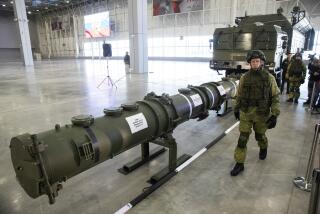Bigger Blunder
- Share via
Even after Reykjavik, where the White House says it came “that close” to history-making cuts in nuclear weapons, President Reagan’s commitment to arms control remains suspect.
There are many reasons for that, but one act alone would raise the doubt: his order last week to break out of the limits on nuclear weapons imposed on both the Soviet Union and the United States by the terms of the SALT II arms-control treaty.
The decision involved ordering one more B-52 bomber equipped to carry nuclear-tipped cruise missiles--weapons that become flying bombs when launched--into active service without retiring another launcher of nuclear weapons. It may well prove a far bigger blunder than anything that his runaway National Security Council did in Iran and Nicaragua.
The President offered no explanation for the move, but that is no surprise. Even a truly great explainer would have trouble squaring the decision to break through the limits on weapons with his opposition to the treaty on the ground that its limits on nuclear weapons were set too high.
One guess was that it was a way of tightening the screws on Moscow to get it to take arms control more seriously, but nothing in recent Soviet history suggests that its leaders respond that way to pressure.
Someone else in government said that perhaps the White House was trying to avoid appearing weak during the turmoil over disclosures of arms sales to Iran, with the profits going to rebels fighting the government in Nicaragua.
The Reagan Administration contends that the Soviets cheated on SALT II by building a radar station in Siberia that clearly would be in violation if the Soviets finished it and threw the switch, and by deploying two missiles that Americans say were not allowed under the treaty.
But there has been no claim of Soviet violations as direct as that of exceeding the ceiling on the number of weapons that carry more than one warhead, as the United States has done by adding the B-52 to its fleet. And arms-control specialists outside government have contended that the way to deal with suspicions of cheating would be to use channels spelled out in SALT II, not join the Soviets in violating the agreement.
Arms control is a companion to the Cold War, not a partner in peace. Until the bold proposals of Reykjavik, arms-control treaties were treated as ways for both nations to step cautiously back from stocks of nuclear weapons that far exceed need without giving an advantage to either. The process has always been supported, within limits, by military leaders in both countries if only because it provided a framework for military planning, a way of guessing how much was enough.
A majority of members in Congress see arms control the same way, and they appealed to the President last October not to break the SALT II limits. The next step probably will be to make that appeal binding by using the powers of Congress over spending. That is clear encroachment on the powers of the presidency, but it may be the only way to preserve the arms-control process.
More to Read
Sign up for Essential California
The most important California stories and recommendations in your inbox every morning.
You may occasionally receive promotional content from the Los Angeles Times.










